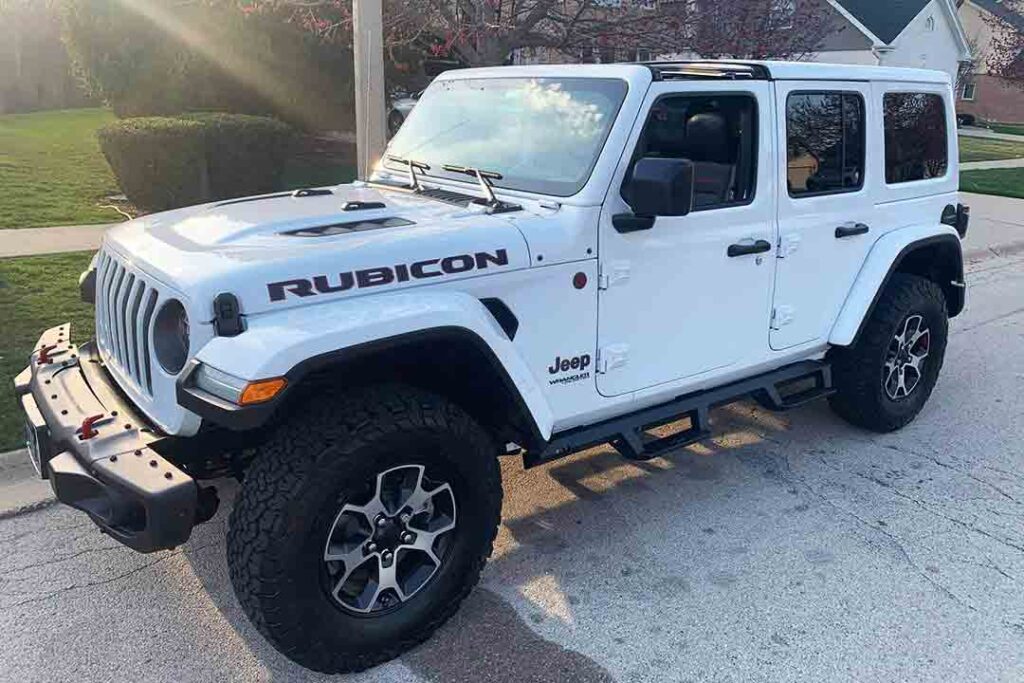Jeep 6 Speed Manual Transmission Problems: A Comprehensive Guide
The Jeep 6 speed manual transmission is popular among off-road enthusiasts and those who enjoy the thrill of driving a manual vehicle because it provides a direct connection between the driver and the car, resulting in an engaging driving experience. However, as time goes on, you may experience some Jeep 6 speed manual transmission problems.
Difficult gear shifting, clutch failure, slippage, premature wear, shifting issues, first and reverse gear popping, odd noise, and transmission parts wear are some of the most common Jeep 6-speed manual transmission issues.

I’ll go over them in detail as well as their solutions. I will also discuss how to take care of your Jeep manual transmission to ensure its longevity and peak performance and highlight some of the symptoms of a faulty transmission.
Table of Contents
The Jeep 6 Speed Manual Transmission
Also known as the New Venture Gear 370 (NSG370), Jeeps have been equipped with this popular transmission since 2005. It was first used in the Jeep Wrangler TJ and has since been incorporated into all ensuing models, including the JK, JL, and JLU.
It is renowned for its sturdy design and capacity to withstand the demands of both on- and off-road driving.
Getrag developed the NSG370 as a top-shifted aluminum-case unit. It weighs 89 pounds, has a torque rating of 272 pound-feet, and has a total fluid capacity of 1.9 quarts.
It is a close-ratio transmission, meaning the gear ratios are close together. It improves acceleration and fuel economy.
The clutch operates smoothly thanks to the hydraulic clutch system, which engages and disengages the clutch.
Each gear has multi-cone synchronizers, which make gear engagement smoother and cause less gear grinding. These synchronizers are crucial in ensuring smooth gear shifts.
It is paired with a transfer case like the NV241 or NV241OR. The transfer case improves traction and off-road capabilities by switching between 2WD and 4WD modes.
Routine maintenance is necessary to keep the NSG370 transmission functioning at its best.
Common Jeep 6 Speed Manual Transmission Problems
While the Jeep 6 speed manual transmission is generally dependable and long-lasting, it can develop problems over time. Addressing the common issues for a smooth and secure ride is critical. Let’s look at potential causes and fixes for the typical problems with the Jeep 6 speed manual transmission so that you can deal with these problems successfully.
Difficult or Noisy Gear Shifting:
Difficulty shifting gears or unusual noises during gear changes can indicate various transmission problems, including worn or damaged synchronizers, clutch linkage problems, or incorrect clutch system adjustment.
Inspect the transmission and clutch systems. You may need to replace the worn synchronizers. You may need to adjust the clutch linkage or pedal for proper operation.
Clutch Pressure Plate Failure:
The pressure plate, responsible for exerting pressure on the clutch disc, can overheat and break under certain conditions. Then it can crack the transmission case, causing it to fall apart.
Fragments of the fractured pressure plate can touch adjacent components, leading to a fire. Furthermore, vehicle parts that fall off can cause a hazard for others on the road and increase the risk of injury.
In 2021, Jeep issued a recall for some specific models equipped with a 6-speed manual transmission. The issue was identified as a software failure that caused the pressure plate to overheat.
Jeep advises impacted owners to visit a licensed dealership to prevent damage to the pressure plate. There, technicians will install software limiting an engine’s ability to generate torque when the clutch assembly temperature increases.
Clutch Slippage:
Another common issue with manual transmissions is clutch slippage. When this happens, the transmission does not engage completely. Hence, the transmission doesn’t get full power from the engine. Wear on a clutch disc, such as the disc or release bearing, can result in clutch slippage.
Depending on the extent of wear, the clutch components may need to be replaced. Check the clutch system for wear. Replace the parts that are worn out.
Premature Clutch Wear:
Aggressive driving styles, improper clutch usage, or a malfunctioning clutch system can cause premature clutch wear. Slipping, trouble shifting, or a vibrating clutch pedal all indicate premature clutch wear.
Use appropriate driving techniques, such as not riding the clutch or avoiding excessive clutch slipping. Check and adjust the clutch frequently. It might be necessary to replace the clutch components if they have significant wear.
Shifter Pops off First Gear:
Owners of Jeep Wranglers complain of the gear shifter popping out of first gear, especially when accelerating from a stop. The overall driving experience becomes less enjoyable because of this annoying issue.
A potential solution is to remove the gear shifter knob and boot to access the inner boot and ensure that the inner boot is positioned correctly. The issue can also be fixed using a cushioning material to prevent the shifter from contacting the housing. Sometimes you may need to swap the shifter itself.
Shifter Pops off Reverse Gear:
Reverse gear popping out is another issue that some Jeep owners have. This issue is most commonly encountered after performing a body lift. The underlying problem of something obstructing gear engagement also applies to reverse gear.
To resolve this issue, remove the shifter’s outer and inner boots and inspect the shifter’s position and inner boot alignment. To ensure a proper fit, cut the inner boot if necessary. A new reverse gear assembly may be required in more severe cases.
Input Shaft Bearing Noise:
Sometimes noise comes from the input shaft bearing of the 6-speed manual transmission. When operating, this may produce a whining or grinding sound. This is due to a worn or damaged input shaft bearing.
For a long-lasting solution, replace the worn input shaft bearing and check the other related parts. Replace the bearings with caution and make sure they are installed correctly.
Excessive Vibration:
Several factors can contribute to an excessively vibrating clutch engagement, including a worn clutch disc, a broken flywheel, or a problem with the alignment of the transmission components.
The key to restoring smooth operation is locating the vibration’s cause and making the necessary repairs or replacements. Look for worn parts in the clutch system. Realign the components of the transmission and replace the worn parts. Resurface or replace the flywheel if necessary.
Premature Wear and Tear of Internal Transmission Parts
Use the right gear oil to prevent premature wear of the internal parts. The MS-9224 gear oil is required by the NSG370 transmission, and using a different oil can result in a number of gear-shifting issues. Regular over-the-counter lubricants might not offer the required protection, which can cause the transmission to fail early.
It is important to keep in mind that the likelihood of these issues can vary depending on elements like how you use the vehicle, maintain it, and behave behind the wheel.

Maintaining the Jeep 6 Speed Manual Transmission
The transmission’s longevity, effectiveness, and dependability depend heavily on routine maintenance. You can maintain your transmission in top condition by doing the following:
1. Fluid Checks and Changes:
Monitor the level of the transmission fluid. Poor shifting performance and increased wear can result from low or contaminated fluid.
2. Use the Correct Gear Oil:
Make sure you are using the proper gear oil that the manufacturer has recommended for the manual transmission in your Jeep. You must use the correct gear oil to maintain proper lubrication because different transmissions may require different types or viscosities of gear oil.
3. Clutch System Inspection:
Check the clutch system periodically. See if there is any damage. Verify that the clutch pedal has adequate free play and is operating smoothly. Any slipping, trouble shifting, or vibrations can be signs of trouble.
4. Avoid Aggressive Driving Habits:
Your transmission’s components may become overworked due to aggressive driving, such as hard shifting, excessive clutch slipping, or abrupt clutch engagement. Avoid over-revving the engine, and drive smoothly using gentle gear shifts.
5. Proper Clutch Usage:
Use the clutch in the right way. It’ll reduce wear and make the clutch components last longer. Release the clutch smoothly and gradually when starting from a stop.
6. Avoid Stepping on the Brake Unnecessarily:
Don’t rest your foot on the brake, as the engine and transmission work too hard when your foot is constantly on the brake pedal, which leads to premature transmission component wear.
7. Smooth Shifting:
Use smooth shifting techniques to lessen the strain on the transmission’s parts. Avoid abrupt or jarring gear changes because they can cause the synchronizers and gears to wear out prematurely. Before applying throttle when changing gears, let the clutch fully engage.
8. Transfer Case Maintenance:
Conduct fluid changes and inspections if your Jeep has a transfer case to ensure proper operation and lubrication of the transfer case components.
9. Be Mindful of Towing:
If you need to tow something with your Jeep, adhere to the suggested towing weight listed in the owner’s manual to prevent undue stress on the transmission. Long-term damage and overheating can result from excessive towing.
10. Warm-Up Your Vehicle:
Warm up your Jeep’s engine briefly before starting it in colder weather. It improves oil flow and provides adequate lubrication for the transmission parts.
You can minimize future issues and lengthen the life of your Jeep 6 speed manual transmission by incorporating these maintenance procedures into your routine.
Symptoms of a Bad Transmission
If your transmission has issues, it is critical to identify the symptoms immediately. If you do that, further damage will be avoided, and the repair cost will come down.
1. Gear Shifting Issues:
Difficulty in shifting gears or gears grinding during engagement can be a sign of transmission problems. This can include hesitating, resisting, or not being able to shift between gears smoothly.
2. Slipping Transmission:
In a slipping transmission, the engine revs higher than usual, but the speed doesn’t increase. Even when you increase throttle input, the vehicle may appear to struggle to accelerate or maintain speed.
3. Delayed Engagement:
A delay between shifting into gear and the transmission engaging can indicate a problem. This delay can also come before the vehicle begins to move forward.
4. Unusual Noises:
Unusual transmission noises can indicate problems. Grinding, whining, clunking, or buzzing sounds may occur during gear changes or while the vehicle is in motion.
5. Transmission Fluid Leaks:
Transmission fluid leaks are signs of a problem. You may notice red or brown fluid pooling beneath the vehicle. Low fluid levels can result in insufficient lubrication and transmission failure.
6. Overheating:
Frequently overheating transmission indicates an underlying problem. Low or restricted fluid flow and faulty cooling systems can cause overheating. Also, towing or heavy loads can strain the transmission excessively, causing overheating. If not addressed quickly, overheating can cause significant damage to the transmission.
7. Dashboard Warning Lights:
Some Jeep models have dashboard warning lights specifically designed to indicate transmission issues. If you notice a “Check Engine” or “Transmission” warning light, or any other related warning lights, you must have the vehicle diagnosed.
With the above symptoms, a proper diagnosis and making any necessary repairs is critical. Prompt attention to transmission problems can help prevent further damage, lower repair costs, and increase the longevity and performance of your Jeep’s transmission.
Read More: How To Fix Jeep Wrangler Automatic Transmission Shifting Problems? – 6 Methods Explained
Final Words
The Jeep 6 speed manual transmission provides an engaging driving experience for Jeep owners. However, it can experience some problems. Regular maintenance is essential for maintaining the transmission’s performance and reliability.
When experiencing transmission problems, keep notes of what occurs and your activities at the time. That way, you can figure out how to replicate, explain, and demonstrate it to your dealership.
You can ensure a smooth and enjoyable driving experience with your Jeep 6 speed manual transmission by staying proactive with maintenance and addressing any problems as soon as they arise.
